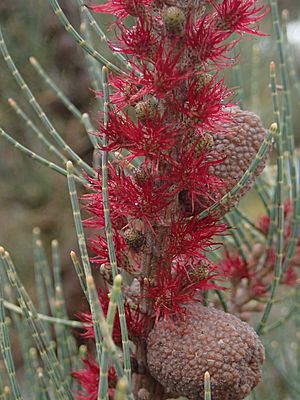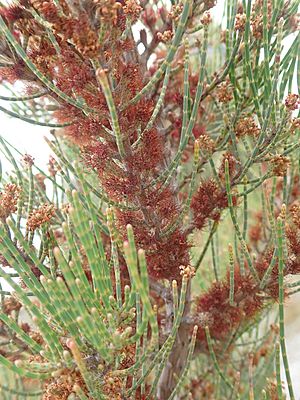Dwarf sheoak facts for kids
Quick facts for kids Dwarf sheoak |
|
|---|---|
 |
|
| Allocasuarina humilis - female plant: flowers & fruits | |
 |
|
| Entire shrub | |
| Scientific classification | |
| Genus: |
Allocasuarina
|
| Species: |
humilis
|
 |
|
| Occurrence records downloaded from AVH, 22 June 2018 | |
| Synonyms | |
|
|
The dwarf sheoak or dwarf casuarina (scientific name: Allocasuarina humilis) is a small, woody shrub. It belongs to the plant family called Casuarinaceae. This plant is special because it only grows naturally in the south-west part of Western Australia. This means it is endemic to that area.
Contents
About the Dwarf Sheoak Plant
Unlike many other sheoak plants that grow into tall trees, the dwarf sheoak stays small. It usually grows to be only 20 centimeters (about 8 inches) to 2 meters (about 6.5 feet) tall. It has many branches that grow upwards from its main stems. These smaller branches can be up to 12 centimeters (about 5 inches) long.
What its "Needles" Are Like
The dwarf sheoak's leaves look like thin, green needles. But they are not true leaves! They are actually special stems called cladodes. These cladodes are made of many small parts, like a string of beads. The real leaves are tiny teeth that wrap around each joint on the cladode.
How Dwarf Sheoaks Reproduce
Dwarf sheoaks can have male and female flowers on the same plant, or on different plants. This is called being dioecious or monoecious. The male flowers are reddish-brown spikes, about 6 to 18 millimeters long. The female flowers grow into bumpy, cylinder-shaped cones. These cones are about 12 to 22 millimeters long and 10 to 17 millimeters wide.
Naming the Dwarf Sheoak
The dwarf sheoak was first described in 1841. Two German scientists, Christoph Friedrich Otto and Albert Gottfried Dietrich, gave it the name Casuarina humilis. They studied a plant that was growing in the Berlin Botanical Gardens.
Later, in 1982, a botanist named Lawrie Johnson moved this plant to a new group. This new group of plants is called Allocasuarina. The name humilis comes from a Latin word. It means "on" or "close to the ground," which makes sense for a dwarf plant!
Where Dwarf Sheoaks Grow
You can find Allocasuarina humilis all over the southwest of Western Australia. It grows from the Murchison River in the north, all the way to the south coast. It can even be found as far east as Israelite Bay. This plant is tough and can grow in many different types of soil. It likes sand, sand mixed with laterite (a type of soil), gravel, or clay.
Growing Dwarf Sheoaks in Gardens
The dwarf sheoak is a great plant for gardens. It can grow well in many different places. It likes sunny spots and can handle many kinds of soil, even some that are a bit alkaline (not acidic). It can also handle some salty air from the coast. People often plant it to help stop soil from washing away or to block wind. Unlike some other Australian native plants, it can even handle a little bit of phosphate fertilizer, which is good for growing.


